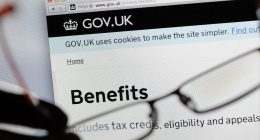
WASHINGTON — After a brutal year of rising prices and economic uncertainty, the country is ending 2022 with some signs of hope that inflation is cooling as the job market remains strong. But economists and CEOs warn the economy will remain on shaky ground in 2023, which could mean another turbulent year for consumers.
The year ended with a mixed picture for the economy. The Federal Reserve’s preferred inflation measure indicated price increases slowed in November, although they were still higher than usual. Consumers spent more this holiday season, but with prices up, they got less bang for their holiday bucks. Despite high-profile layoffs at tech and media companies, unemployment remained relatively low in November, at 3.7%.
Still, economists predict a 70% chance of a recession in 2023, more than double the odds they gave six months ago, according to a survey by Bloomberg. But just how painful that slowdown would be depends on a variety of factors at home and abroad, including how the latest Covid outbreak in China plays out, what steps the Federal Reserve takes on its path to cool inflation and how much employers scale back their workforces.
Here are four things to watch for in the economy in 2023:
Covid’s toll on China
While Covid infections in China may seem like a remote concern for most Americans, their ripple effects throughout the economy are expected to have big implications given China’s vital role as a trading partner to the U.S. and a major global consumer of oil and gas.
After months of strict lockdowns that caused rolling disruptions to supply chains and greatly stifled demand from Chinese consumers, China began lifting its Covid restrictions in recent weeks. Now, the highly contagious omicron variant of the coronavirus is rapidly starting to spread. China has stopped releasing official case counts; one Shanghai hospital said last week it expected half of the city’s 25 million people to get infected in the coming days, Reuters reported.
China’s latest outbreak is resulting in another wave of supply chain disruptions as factories shut down with workers out sick, and it’s unclear how long it will take for infections to ebb and businesses to return to some semblance of normal.
“China will eventually learn to live with Covid, but it’s going to be a really rocky path to get there, as we all experienced here, just much earlier,” said Megan Greene, the global chief economist at the Kroll Institute, an economic research firm.
Once China does make it through the worst of the pandemic, there is expected to be a surge in oil used by Chinese consumers who have largely been stuck at home and unable to travel for months. The return of China’s demand for oil could drive global prices higher, affecting Americans filling up their gas tanks.
“The most important thing for 2023 is by far China’s Covid policy,” Dan Klein, the head of energy pathways at S&P Global Commodity Insights. “China had virtually no growth in energy demand in 2022, which is pretty stunning, to say the least.”
The Fed’s next move
The Federal Reserve has been trying to put the brakes on decades-high inflation by raising interest rates since March in hope that creating higher borrowing costs for consumers and businesses will slow spending and price increases.
The actions have taken their toll on some parts of the economy, like the housing market, but the impact on other sectors will be felt more acutely in 2023, economists forecast.
“The Fed has done its work and it will have more to do, but we don’t know exactly when that effect hits the economy,” said Glenn Hubbard, a professor of economics at Columbia University who was the top economic adviser to President George W. Bush. “So I do expect a recession in 2023, assuming the Fed continues on the path that I expect, but obviously, the Fed remains a big risk.”
The key question in 2023 will be how many more rate increases the Fed will make and for how long rates will stay high as the effects work their way through the economy.
While Greene, the Kroll Institute economist, believes the worst of inflation is behind the country, she doesn’t believe it will be getting close to the Federal Reserve’s 2% target by the end of 2023. As a result, the Fed will be forced to continue raising rates and keeping them high throughout the next year. Ultimately, she expects unemployment will have to rise to 5% before consumer spending slows enough to have a significant drag on inflation.
“That’s millions of people who will be out of jobs, and so that will have a real impact on a lot of individuals. I think that is when consumers are really going to retrench, when the labor market starts to deteriorate,” Greene said. “It’s when people are laid off or they know people who are laid off that consumers tend to really shift their consumption patterns and retrench for the rainy day.”
What comes next for the housing market
While much of the economy continued plowing ahead despite the Federal Reserve’s rate hikes, home sales fell for 10 consecutive months and were down by 35% in November compared to a year earlier.
But there are signs the turbulent housing market will start to stabilize in 2023, even as the wider economy remains on shaky ground, said Lawrence Yun, the chief economist for the National Association of Realtors, which predicted that home sales would decline by 6.8% in 2023 compared to 2022.
Despite the Fed’s rate hikes over the past year, Yun expects mortgage rates will come down slightly and prices will hold steady, with the median home price increasing by just 0.3% from 2022 given that demand for houses continues to outstrip the supply. But much will depend on how the wider economy unfolds and how long the Fed keeps rates at or above their current levels.
“Any possibility of a robust activity is simply not there. The question is whether the economy can be slightly above the positive line or will slip slightly under zero to go into a recession,” Yun said. “So I think that is the key question for the U.S. economy.”
Yun expects rents to continue rising, although at a slower pace than in 2022.
Supply chain snarls
Helping keep prices stubbornly high has been a shortage of products and materials that has persisted more than two years into the pandemic. Covid infections have continued to shut down factories around the world, aggravated by China’s loosening of Covid restrictions.
Russia’s invasion of Ukraine has limited the supply of crucial materials used in manufacturing, and the war continues to create uncertainty about the supply of energy, particularly for European manufacturers.
The problems have been particularly acute in the auto industry, which has experienced persistent shortages of microchips, along with an array of other spot shortages of parts and materials. Congress passed legislation this year to help boost domestic production of chips, but it will take several years for that supply to come online.
In the meantime, with demand outstripping supply, car prices are up by nearly 24% over the past two years. Industry analysts expect limited inventory to continue through 2023, keeping prices relatively high.
Retailers have struggled to find the right balance between supply and demand as they ended the year trying to clear through warehouses stuffed full of the wrong merchandise as consumer spending habits shifted. Those spending partners could change again if the U.S. enters a recession.
Big questions for 2023 will be how much those supply chain disruptions will be resolved and what impact that will have on helping ease overall inflation.
Source: | This article originally belongs to Nbcnews.com









